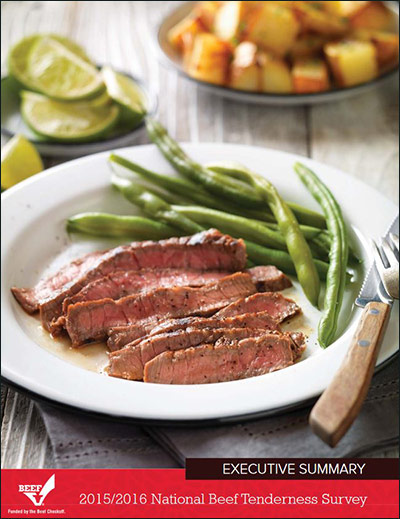Checkoff Study: Beef Maintains Favorable Tenderness Ratings
Cuts from the round primal remain a tenderness challenge.

Favorable tenderness ratings for beef steaks, which have improved significantly since 1990, have remained steady during the past five years, recent research shows. This quality retention has occurred despite environmental and financial challenges that could have derailed its progress. Funded by the beef checkoff, the 2015-2016 National Beef Tenderness Survey was conducted at Texas A&M University, which has surveyed beef tenderness regularly since 1990.
“Despite some challenges during the past 10 years, including drought, fluctuating supply and rising input costs, the tenderness of the beef being produced in the United States has remained steady, and often improved,” according to Jeffrey Savell, the lead investigator of the research at Texas A&M. “Beef is delivering a good eating experience to consumers, and this research suggests the industry is keeping its eye on the ball when it comes to protecting the improvements in tenderness it has made.”
Results from the first survey, conducted in 1990, confirmed that significant tenderness issues existed with cuts from the chuck, round and sirloin. During the next 15 years, tremendous improvements in tenderness were realized. Results from the 1999 survey showed a 20% increase in tenderness, while a 2005-2006 survey showed an 18% improvement compared to in 1999 — and 34% improvement compared to results in 1990, with most steaks evaluated as tender.
Reasons for the improvement included increased aging time, longer and slower chill rates and more branded programs at retail. In 2005-2006, about 47% of retail cuts were marketed through branded programs designed to guarantee certain quality traits, including tenderness.
While fewer branded products were surveyed compared to a decade ago, results from the 2015-2016 survey found that, as with the 2010-2011 survey, most steaks were considered tender. Warner-Bratzler Shear Force (WBSF) values, an objective measure of tenderness, were consistent with values noted five years ago for ribeye, top blade, top loin and sirloin steaks. Similar to previous surveys, the 2015-2016 survey indicated a need for more industry focus on tenderness and increasing the overall consumer “liking” for cuts from the round. Because the survey shows rounds are sometimes not aged sufficiently, and consumer understanding of the different cooking methods necessary for round cuts is limited, enjoyment of cuts from this primal could be improved, the study suggested.
“Our research proves that all cuts aren’t created equal,” said Savell. “While they have a wonderful flavor profile, cuts from the round remain an industry tenderness challenge. Future focus needs to include a collective effort to utilize optimal aging practices, as well as more support for extensive consumer cooking education for round cuts.”
Savell said that with tenderness goals generally being achieved across many cuts, additional focus and research could be placed by the industry on other quality traits, such as flavor.
For more information about your beef checkoff investment, visit http://www.mybeefcheckoff.com.
Editor’s Note: Melissa Jackson is a trade media manager for the Cattlemen’s Beef Board.







